You’ve probably heard of Banksy, the anonymous street artist whose work appears seemingly overnight on city walls around the world. Banksy’s art blends secrecy and sharp social commentary, transforming ordinary streets into striking public conversations about politics, society, and culture. The allure of his unknown identity only adds to the intrigue, making every new piece a global topic of discussion.
Through clever stencils and bold visuals, Banksy challenges you to reflect on everyday injustices and question authority. His signature style, secrecy, and thought-provoking messages keep both fans and critics eagerly watching, wondering not just what he’ll say next, but where he’ll say it.

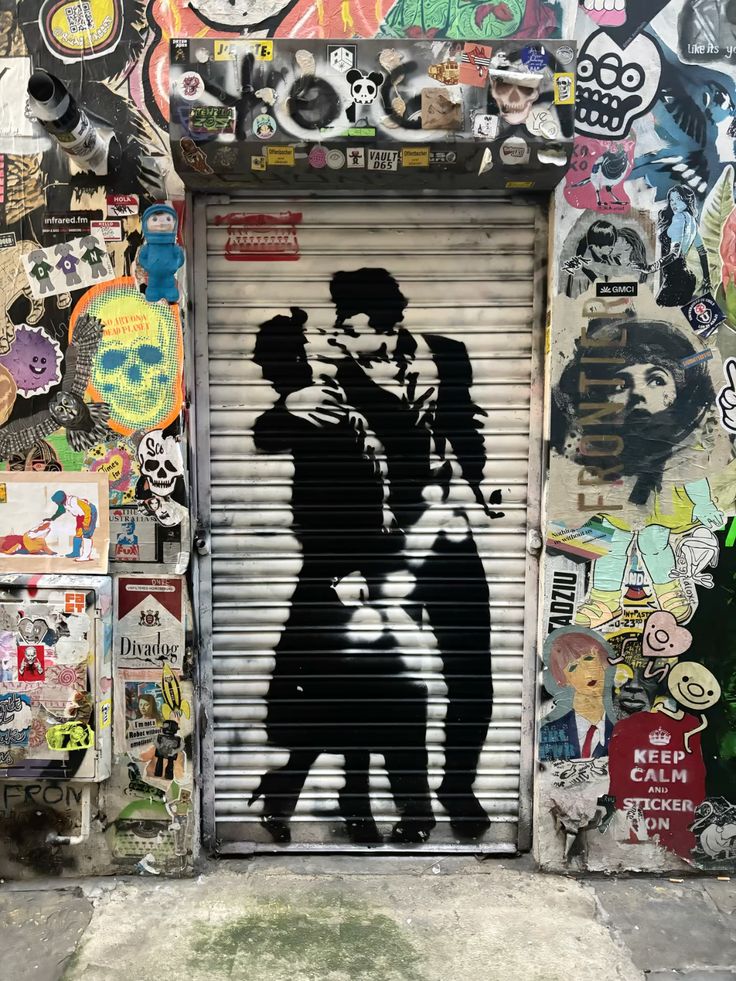
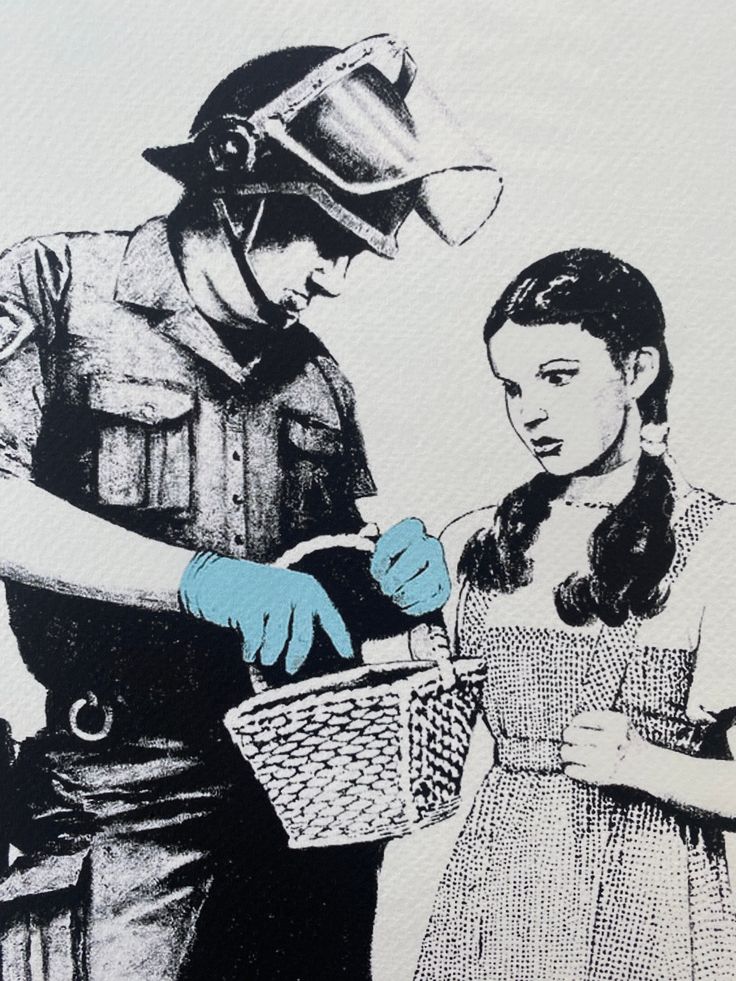
Key Takeaways
- Banksy uses anonymity to amplify his artistic message.
- His distinctive techniques turn social issues into public art.
- Banksy’s work sparks conversations that impact street culture worldwide.
Banksy and the Power of Anonymity
Banksy’s anonymity is not just personal preference—it’s a deliberate tool that shapes how you interpret his art and influence. By remaining unnamed, Banksy changes the way you experience street art, shifting the focus to the message and social commentary.
The Role of Anonymity in Street Art
As a street artist, Banksy breaks from the usual tradition of claiming fame or recognition. Anonymity is crucial in a scene where works often appear illegally on public walls. If Banksy’s identity were public, your attention might shift from art to lawsuits or criminality.
This secrecy helps keep you interested in the art itself rather than the individual behind it. Because street art challenges authority and often sidesteps legal channels, staying anonymous gives Banksy freedom. He can tackle social issues, question norms, and use public space for bold statements without fear of direct legal retribution.
Anonymity also encourages a sense of community ownership. You experience his work not as a signed product but as a public statement. This approach has helped street art, traditionally seen as vandalism, gain wider cultural recognition.
Mystery and Media Attention
Banksy’s anonymity creates a constant buzz in media and pop culture. Every new piece invites curiosity—who did it, when, and how? You notice that stories about Banksy often emphasize this mystery, turning each artwork into an event.
This elusive persona means your conversations focus less on personal drama and gossip. Instead, speculation becomes part of the fun. Tabloids and journalists routinely debate his identity or suggest possible suspects, but no concrete evidence has surfaced.
Because you don’t know who’s behind the stencil, Banksy almost becomes an idea rather than a person. This turns his political and social commentaries into movements rather than just opinions. The aura of secrecy keeps each new work fresh, unpredictable, and widely discussed.
Key effects of Banksy’s mystery:
| Effect | Description |
|---|---|
| Media fascination | Frequent headlines, documentaries, debates |
| Public intrigue | Ongoing speculation about true identity |
| Cultural legacy | Mythology adds value to both art and message |
Focusing on Art Over Artist
By staying anonymous, Banksy shifts your attention to the message behind the images, not personal fame. You don’t see lengthy interviews or public appearances; instead, you engage directly with challenging themes on war, inequality, and authority.
This lack of a public persona forces critics, fans, and even casual viewers to analyze what is actually painted on the wall. The dialogue centers on “what does this picture mean for you or for your society?” rather than the artist’s lifestyle or career ambition.
You encounter the art in your own context, free from author’s background or celebrity status. Even when Banksy’s pieces fetch high auction prices, the mystery keeps you guessing whether the attention is about the art’s message or just a commodity. Anonymous art, especially in the case of Banksy, asks you to judge ideas, not just reputations.
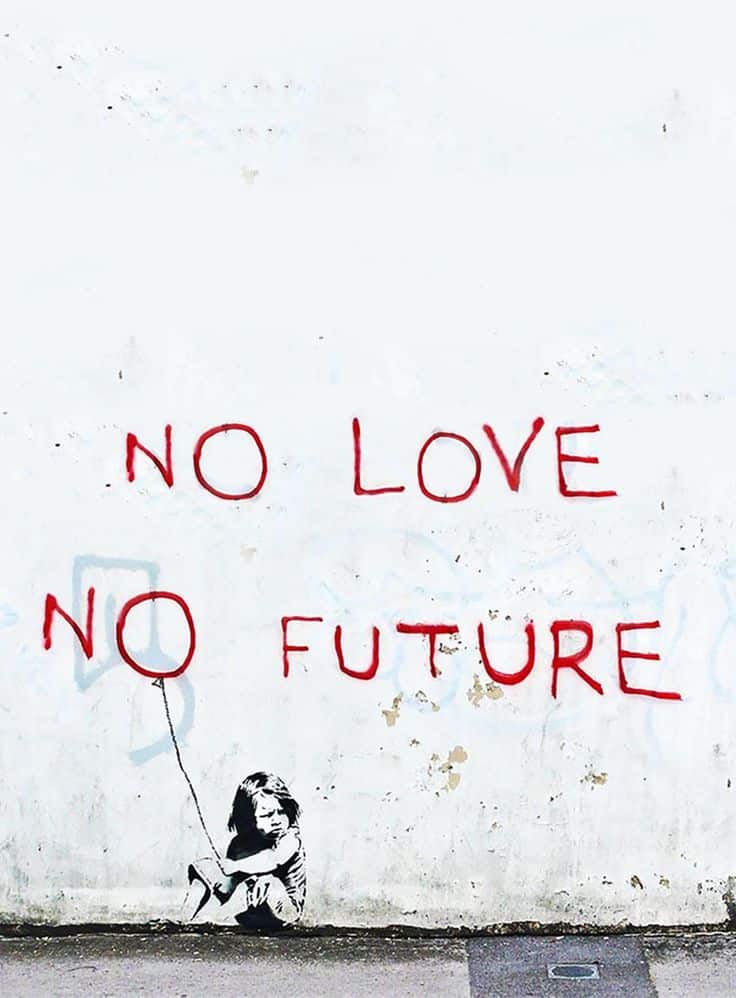
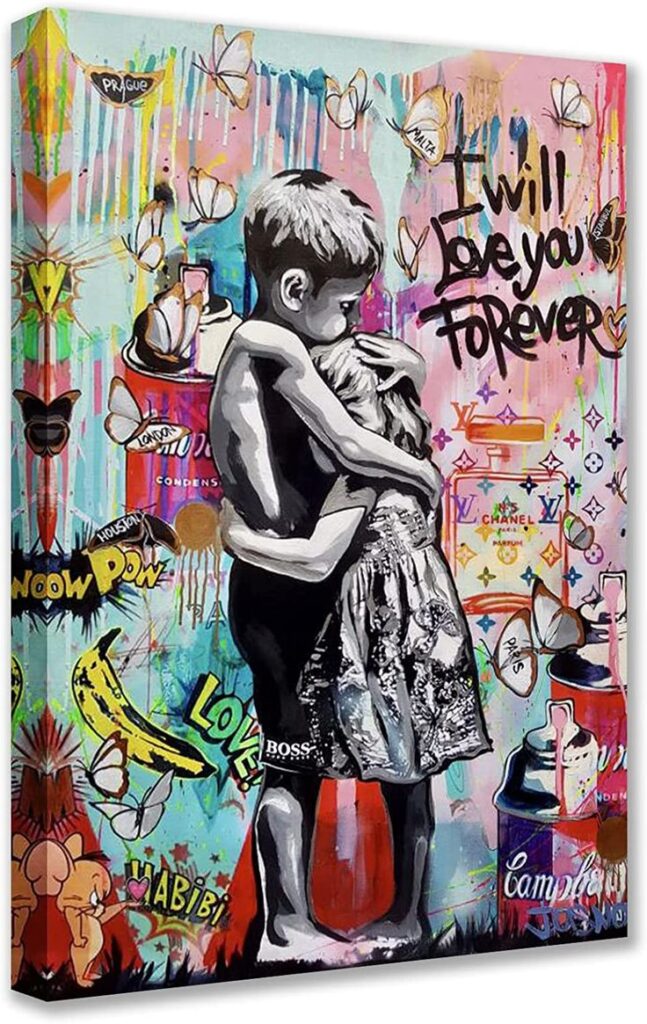

Signature Styles and Techniques
Banksy’s art stands out by blending rapid stencilling methods, a clever use of urban space, and foundations in classic graffiti. You can trace the uniqueness of his approach to the way he adapts tools and settings traditionally reserved for street-level expression.
Stencilling Technique and Speed
Banksy’s stencilling technique is central to his identity as an artist. Stencils allow for the creation of detailed, intricate images in a matter of minutes. With street art, speed is essential, and you’ll notice how quickly his pieces can appear overnight, minimizing the risk of detection.
He often uses multi-layered stencils to build up complex scenes and textures. This method helps him achieve clean, sharp lines and monochrome effects. The result is imagery that looks almost screen-printed, drawing the eye to bold contrasts and satirical details.
Key features of Banksy’s stencilling approach:
- Quick execution
- Consistent lines and shading
- Ability to produce repeatable motifs across different locations
By working fast and efficiently, Banksy leaves artwork in public places without being easily identified.
The Use of Public Space
Public space is more than just a backdrop in Banksy’s work—it’s an active part of the message. You’ll find his art on city walls, bridges, and corners where everyday life happens. By placing socially charged images in these locations, he brings art and commentary directly to passersby.
This choice of site often amplifies his point. For example, a child painting a rainbow on a bleak wall or a rat peeking out from a crumbling brick can turn urban decay into a canvas for reflection. Banksy’s site-specific installations prompt viewers to pause and consider their surroundings.
He turns unremarkable walls into conversation starters. By doing so, you encounter art unexpectedly, sometimes in the middle of your daily routine.
Graffiti Influences
Banksy’s roots are in the graffiti culture of Bristol during the 1990s. Graffiti’s rebellious spirit runs through his approach. Like earlier graffiti writers, he values anonymity, DIY tools, and public visibility. His stencils evolved partly from the need to paint quickly and avoid arrest.
Unlike traditional graffiti—which often focuses on stylized lettering and personal tags—Banksy’s work leans toward narrative scenes and characters. Still, you’ll notice he borrows graffiti’s visual cues, such as spray paint textures and bold, blocky outlines. He keeps the raw, accessible energy of graffiti alive while giving it a satirical edge.
For Banksy, graffiti is both a method and a mindset: accessible, disruptive, and always pushing against the boundaries of the art world.
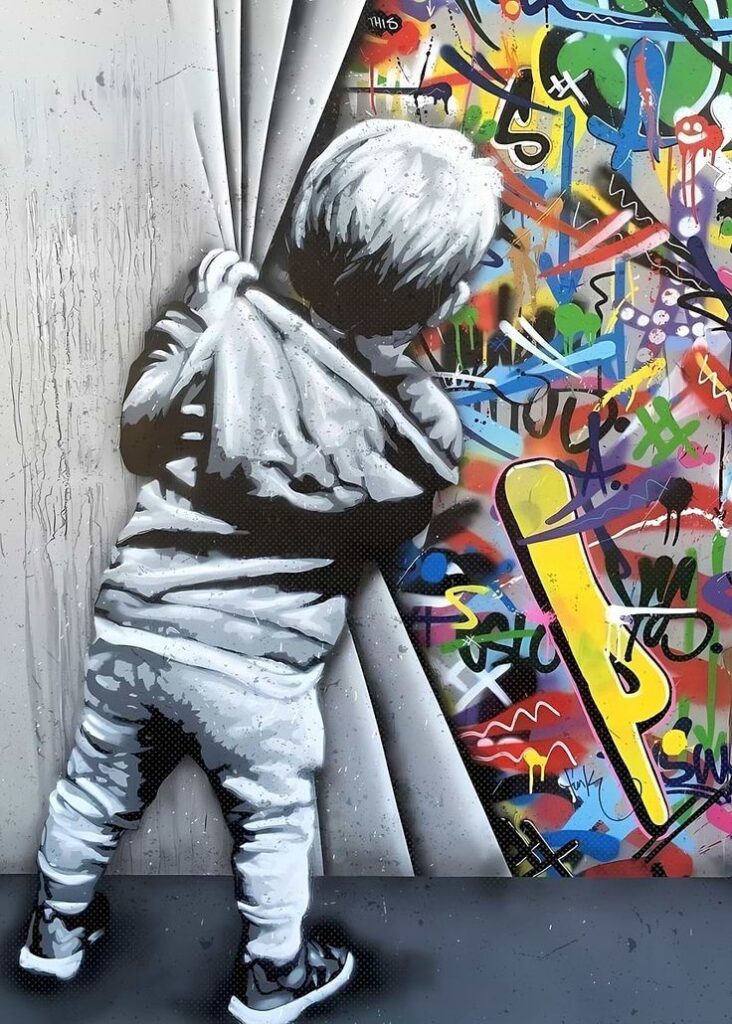

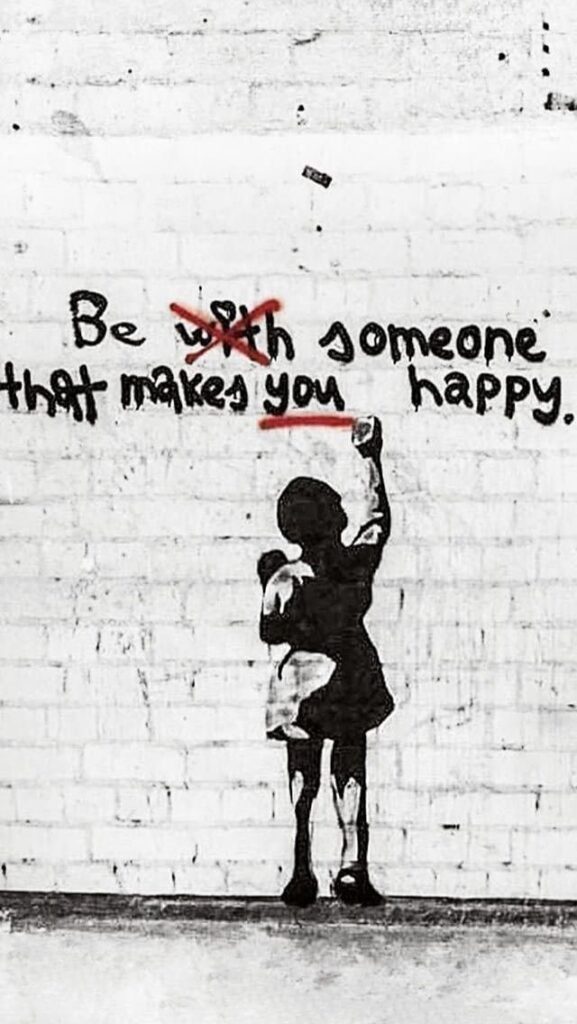
Social and Political Commentary in Banksy’s Art
Banksy’s street art uses visual imagery and irony to examine contemporary social and political issues. You see works that dissect war, highlight economic pain, critique unfettered consumption, and warn about environmental decline.
Critique of War and Violence
Banksy’s art consistently questions the motives and consequences of armed conflict. You might recognize his iconic piece, “Girl with Balloon (Bomb Love),” which pairs innocence with a symbol of destruction.
With works like the mural on the West Bank barrier, Banksy directly addresses the impact of violence on civilian life. Imagery of children at play against backdrops of conflict drives home the contrast between hope and reality.
These pieces don’t just shock, but encourage you to consider how normalized violence has become. Through stenciled soldiers, tanks, and bombers, Banksy exposes the ironies and tragedies of modern warfare.
Satire of Consumerism and Capitalism
Banksy is renowned for his biting satire of consumer culture. You might have seen “Shop Until You Drop,” where a falling shopper represents society’s obsession with material gain.
His pieces such as “Sale Ends Today” and “I Can’t Believe You Morons Actually Buy This Shit” put commercialism under a harsh spotlight. The paintings often feature stark, simple slogans that mock advertising and brand-driven lifestyles.
By parodying luxury culture and wealth idolization, Banksy invites you to question the disparity between aspiration and reality in consumer societies. The satire makes you ask whether accumulation truly brings satisfaction.
Addressing Poverty and Inequality
Themes of poverty and social neglect stand out across Banksy’s portfolio. For instance, in “Sleeping Homeless,” you see the overlooked struggles of the unhoused amid an indifferent world.
Works such as “There Is Always Hope” reference both the difficulties and the persistent dreams of marginalized individuals. Banksy’s scenes are often set in urban environments where inequality is unmistakable.
The art is a reminder to look beyond the surface and confront the real impacts of economic disparity. You are encouraged not only to observe but also to reflect on society’s collective responsibility.
Environmental Degradation Messages
Environmental issues are addressed through visuals that make ecological threats visible. In pieces like “I Don’t Believe in Global Warming,” where the message appears partially submerged in water, you face the stark reality of climate change.
Banksy’s animals—rats, monkeys, and birds—are often depicted suffering or displaced by human activity. This use of animals highlights humanity’s disconnect from nature and the consequences of pollution and neglect.
You are prompted to consider the role of individuals and society in both causing and solving problems related to environmental degradation. The art invites urgent reflection through simplicity and impactful placement.
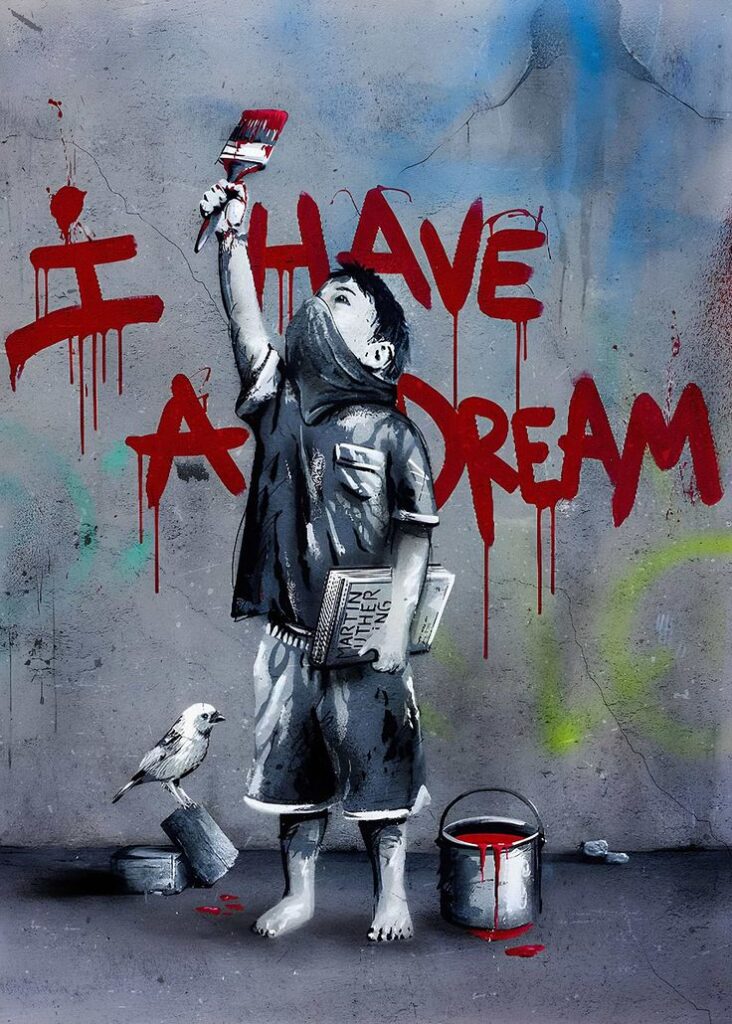
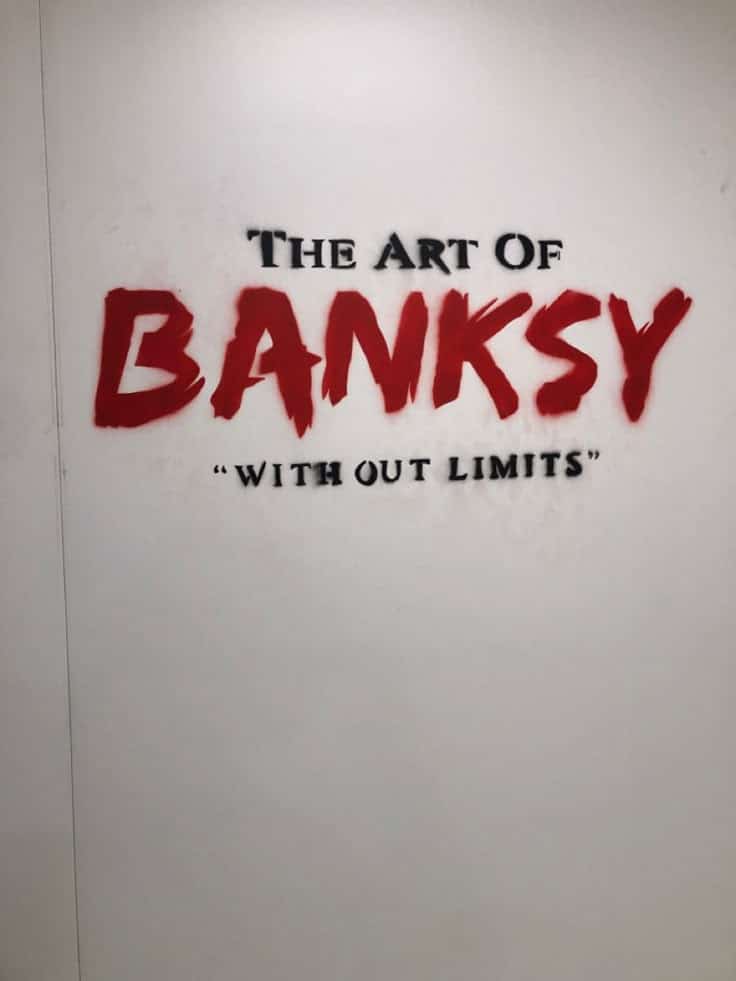
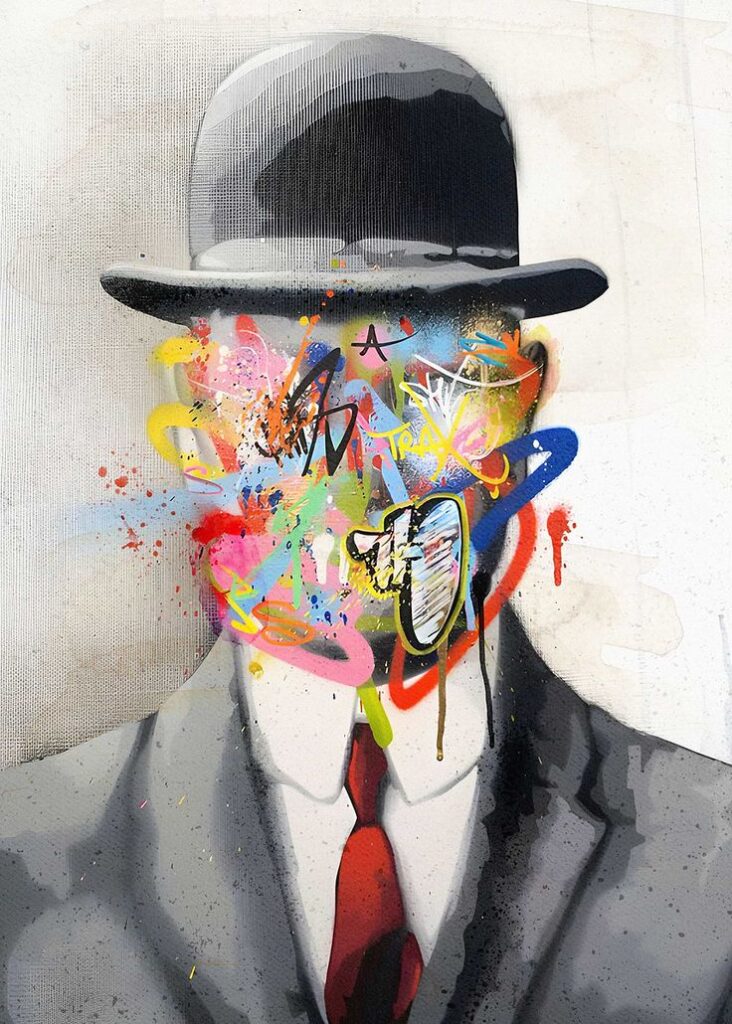
Iconic Works and Their Impact
Banksy’s art often blends visual simplicity with powerful, accessible messages. You’ll notice that his most iconic murals invite direct public reflection on hope, protest, connection, and the realities of modern life.
Girl with Balloon: Symbol of Hope
Girl with Balloon is one of Banksy’s most instantly recognizable images. In this piece, a young girl reaches out toward a heart-shaped balloon that appears to be floating away. This image is stenciled in black and white, with the red balloon standing out as a focal point.
This artwork has become widely interpreted as a symbol of lost innocence, fleeting love, and persistent hope. The placement of the balloon just out of reach emphasizes longing yet also possibility. Banksy sometimes adapts this piece—such as by adding the slogan “There is always hope”—which shapes its emotional impact.
Whether you view it in London or in various reproductions, Girl with Balloon continues to resonate with viewers globally. Iconic sales, such as the 2018 partial shredding at Sotheby’s, have only increased its cultural and commercial significance.
Flower Thrower: Nonviolent Protest
The Flower Thrower, sometimes called Love Is in the Air, depicts a masked protester in mid-throw—not with a weapon, but with a bouquet of flowers. Placed on a West Bank wall in Jerusalem, this mural uses monochrome for the figure, with the flowers vividly colored.
This piece transforms a classic image of aggression into one of peace and hope, challenging your expectations about protest. The flowers symbolize the power of nonviolence, suggesting that ideas and beauty can be more revolutionary than conflict.
The artwork often sparks discussions about whether true change comes from force or compassion. Its placement in a region known for tension adds to its impact, making it a reference point in debates about art and activism.
Mobile Lovers and Modern Connection
Mobile Lovers touches on the role of technology in everyday relationships. In this mural, a couple is shown embracing, but both are distracted by their smartphones, faces illuminated by their screens instead of each other.
Through this image, Banksy prompts you to consider how constant digital connection may come at the cost of real-life intimacy. The work is straightforward yet delivers a clear message about modern isolation, even in moments that should be filled with love and attention.
This mural turned heads when it appeared in Bristol, generating conversations both online and in the press. The property ownership dispute involving the local youth club and city council further highlighted the community impact Banksy can create.
Other Notable Murals
Banksy’s portfolio includes a variety of murals that address topics such as war, human rights, and consumerism. Some standout works include:
- Flying Copper: A police officer with angel wings, blurring lines between authority and innocence.
- Kissing Coppers: Two British policemen sharing a kiss, challenging stereotypes and promoting acceptance.
- Sweep It Under the Carpet: Critiques willful ignorance by showing a maid sweeping dirt behind a curtain.
These murals use bold images and public spaces to push you to reflect on common attitudes and pressing issues. You’ll often see contrasting elements—such as innocence against violence or love in unexpected places—making each work relevant and thought-provoking.
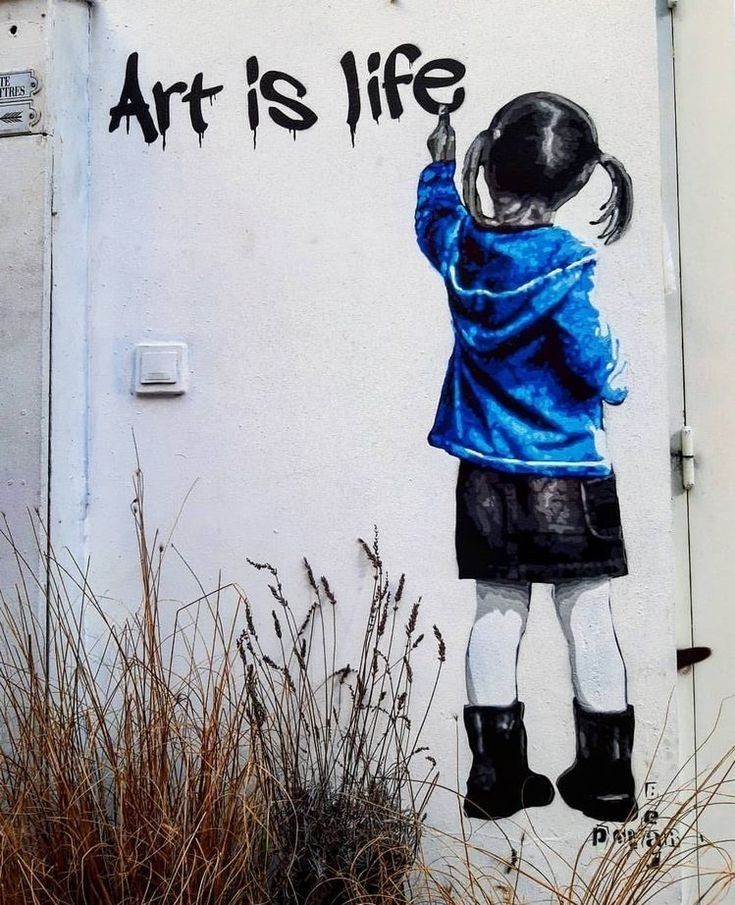
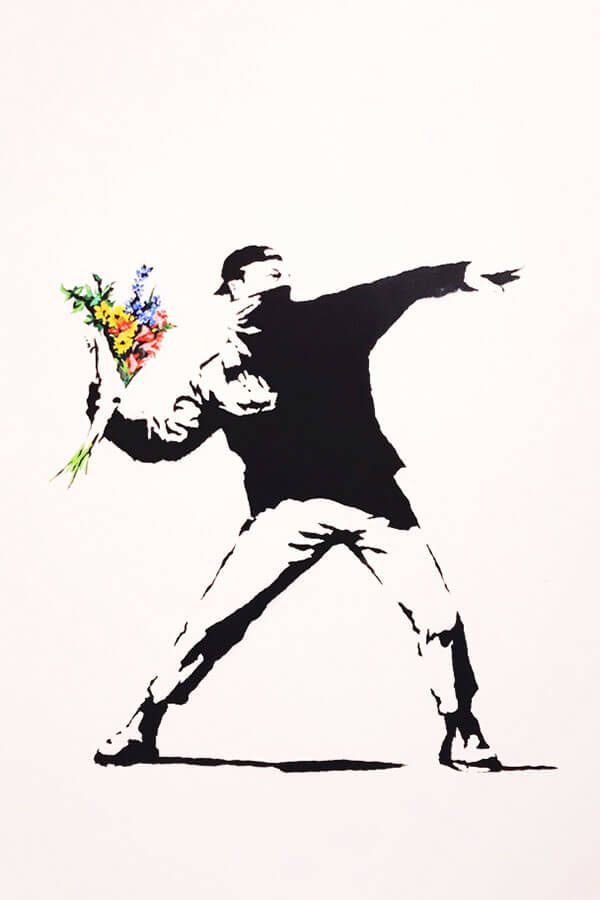
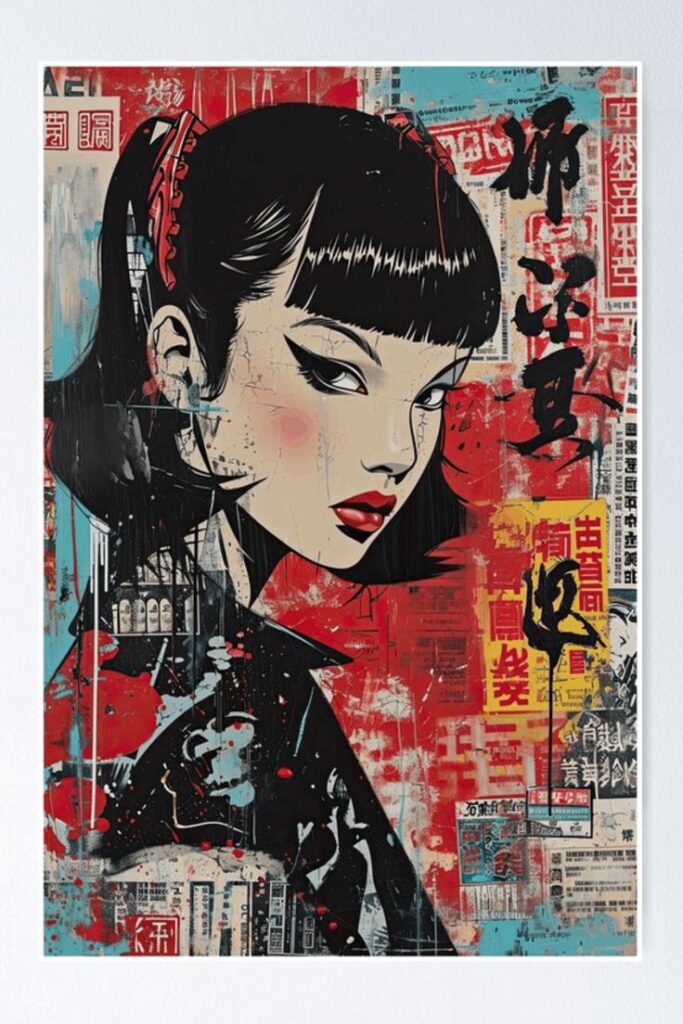
Banksy’s Influence on Street Art and Culture
Banksy has played a significant role in turning public spaces into platforms for creative expression, political critique, and cultural debate. Through anonymity, bold imagery, and accessible art, you can see how his work impacts the wider art world and social conversations.
Shaping Contemporary Street Art
If you’ve walked through any major city, you’ve likely seen street art influenced by Banksy’s signature style: stencil techniques, striking visuals, and thought-provoking themes. Before Banksy, much of street art was dismissed as vandalism, but his approach has helped redefine it as a respected art form.
Emerging artists have picked up banksy’s blending of satire, irony, and clear messaging. His use of public space has made street art more visible and accessible to everyone, not just gallery-goers. As a result, street art is now seen as a legitimate part of contemporary culture rather than an underground activity.
Banksy’s impact is also called the “Banksy Effect”—other street artists have gained recognition in both the mainstream art scene and the marketplace. Today, you can see work inspired by him in cities across the globe, as both local and international street artists follow his lead.
Promoting Social Awareness
Banksy’s work is known for its powerful commentary on society, politics, and injustice. When you see a Banksy mural, it often forces you to consider issues such as war, consumerism, or inequality. These topics appear in relatable and clear imagery, making the messages accessible to people passing by in public spaces.
By using humor and wit, Banksy tackles complex themes without alienating his audience. For example, his murals have critiqued topics like government surveillance and refugee crises, all in places where anyone can view them for free.
What sets Banksy apart is the immediacy of his message—the way he transforms everyday city walls or abandoned buildings into platforms for social critique. This direct communication style helps you connect with social issues that might otherwise be overlooked or ignored.
Challenging Art Institutions
Banksy frequently questions the role of galleries, museums, and commercial art markets. Instead of relying on traditional art spaces, you experience his pieces in unexpected locations—alleys, building facades, train stations, or even on the side of a London house. This challenges ideas about who art is for and where it belongs.
His anonymity and outsider status let him critique the commercial aspects of the art world directly. Banksy’s acts, like shredding his own artwork at auction or staging unauthorized exhibitions, force you to rethink what counts as “real” art and who decides its value.
You might notice that through these actions, Banksy promotes the idea that art should be available to everyone, regardless of social class or education. By bringing art to public spaces, Banksy invites you to engage with art outside of elite circles, making the experience genuinely democratic.
- 318shares
- Facebook0
- Pinterest318
- Twitter0
- Reddit0













